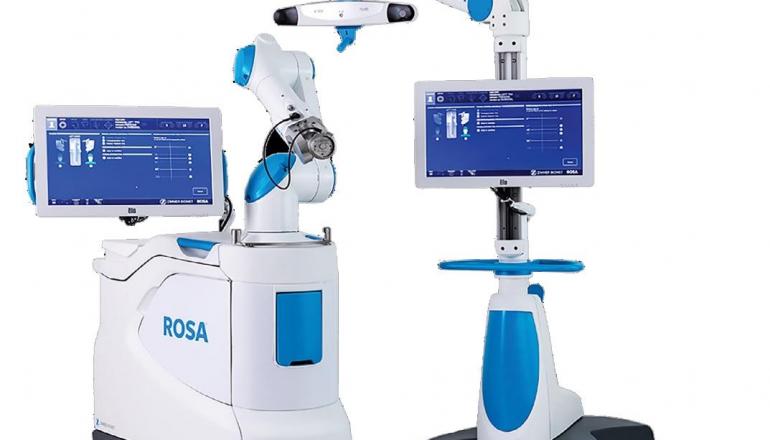
Robotic-assisted total knee replacement for improved surgical outcomes.
Patients at the Hermitage Clinic are now benefitting from precise and personalised knee replacement surgery with a robotic surgical assistant. As a result, patients are able to recover faster and achieve a greater degree of joint flexibility allowing them a quicker return to normal activity.
Total knee replacement surgery is a very common and effective treatment for patients suffering with knee arthritis. However, the success of an individual’s knee replacement surgery is closely linked to the fit and function of the new knee implant. A new robotic surgical assistant called the ROSA Knee System is now being used in the Hermitage Clinic to help support your surgeon to target better fit and function than ever before.
Greater accuracy than traditional methods.
The ROSA Knee System was designed by surgeons for surgeons, bringing together advanced technologies to collect and analyse data before and during your surgery to assist in the planning and placement of your knee replacement. It informs your surgeon of unique details related to your knee that may affect your surgery, helping them understand how they can optimise their surgical plan specifically for you.
Knee replacement surgery using the ROSA Knee System is very similar to traditional surgery. The ROSA Knee system combines precise data and a robotic arm, with your surgeon’s skill and experience, to offer a surgery that results in an implant position more accurately placed than by traditional methods. However, the robot does not perform the surgery, it assists surgeons with live data and guidance throughout the surgery, only moving if the surgeon tells it to.
Faster Recovery than you might think
With technology making many aspects of our lives easier, it is surprising that a recent survey of 2,000 patients found that 38% of patients were concerned that robotic surgery might mean a longer recovery time than conventional surgery. When, in fact, the opposite is true. Robotic-assisted knee surgery has been associated with reduced pain, lower usage of pain relief medication, fewer physiotherapy sessions and overall improved knee function following surgery. Robotic surgery has also been linked to shorter hospital stays and lower rates of hospital readmission compared to traditional surgical techniques
How does ROSA Knee work?
The ROSA Knee System first uses a series of x-rays to create a 3D model of your knee. Based on your surgical needs, your surgeon will advise on a clinically proven knee implant system that is best suited to you. The surgeon will use their experience alongside the information from ROSA to plan specific details of your knee replacement prior to your surgery. During surgery, ROSA uses a camera and sensor to know exactly where your knee is - it can detect even the smallest movements in real-time. Providing live feedback throughout surgery via a digital display and with the help of a robotic guiding arm, ROSA helps your surgeon precisely place the implant according to their plan.
Finally, to ensure the best possible outcome, ROSA helps the surgeon to assess the knee with the implant in place. This allows your surgeon to make final precise adjustments before finishing the surgery. Because of this, robotic-assisted surgery has been shown to improve overall outcomes and is associated with lower post-surgery revision rates.